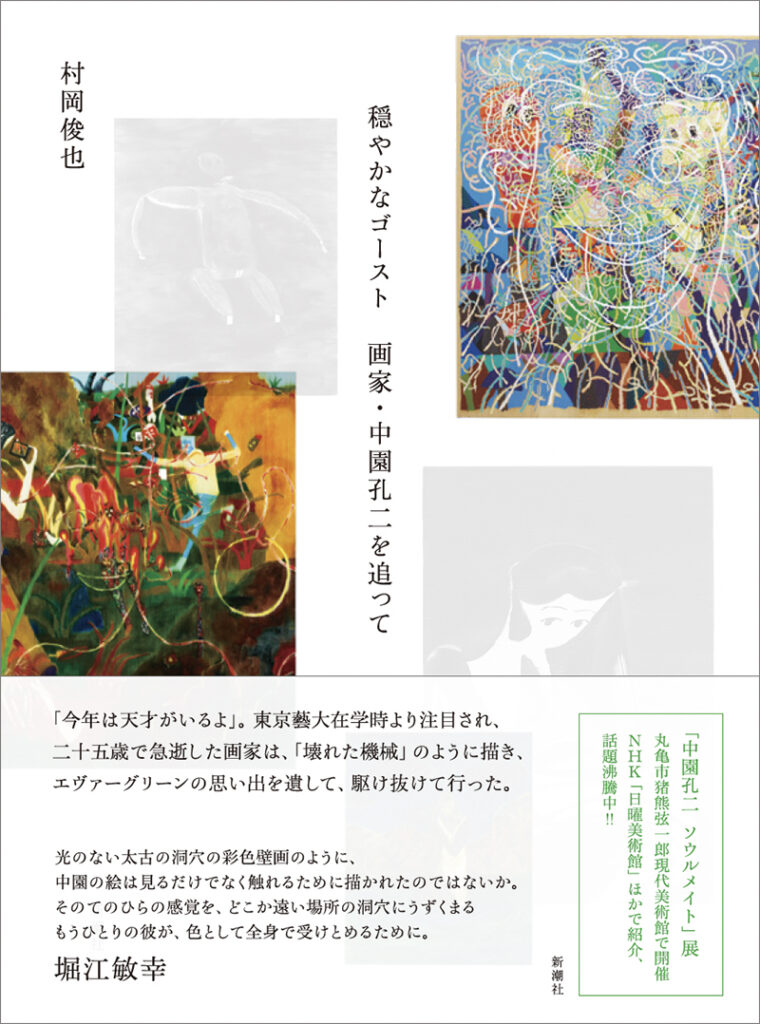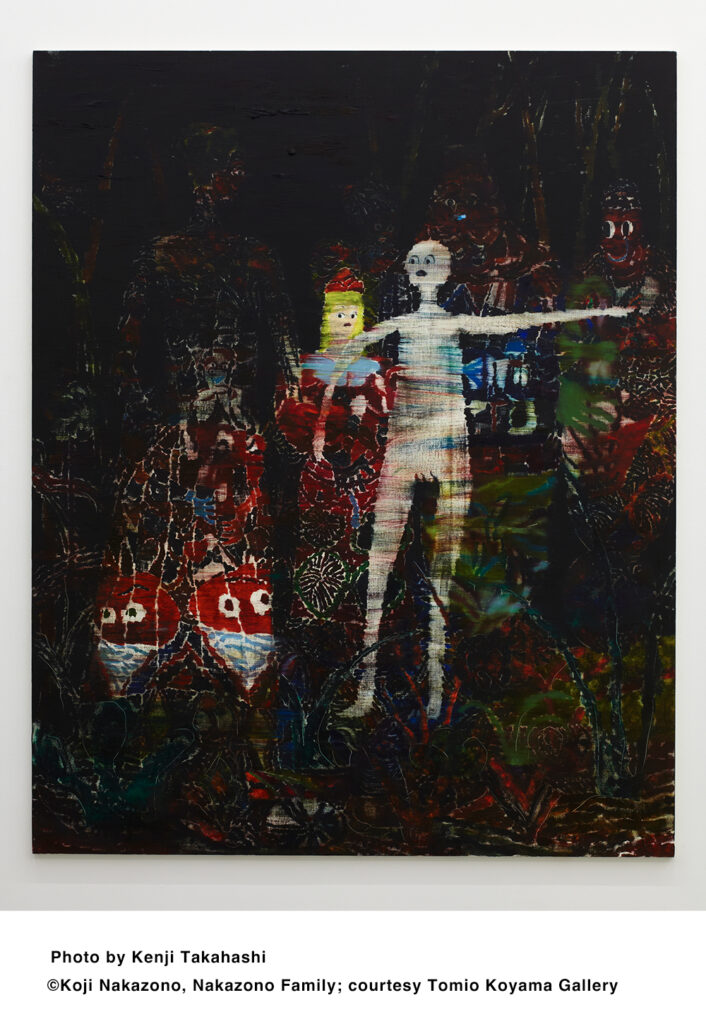
Koji Nakazono, Untitled, 2012, collection of Museum of Contemporary Art Tokyo
The first time I saw paintings by Koji Nakazono was in 2018 at the Yokosuka Museum of Art’s exhibition Koji Nakazono: On the Edge—Places I Wanted to See. The complicated scattering of images didn’t quite sit with me at first; they impressed me only as a child’s doodling. But because I didn’t yet appreciate his work, it stayed with me and kept coming back to mind.
So when a friend and illustrator told me Nakazono was serious enough to attend preparatory art school, and then asked me for help making a book of Nakazono’s memories, I decided to take on the project and write a critical biography. I asked Nakazono’s mother to take me to the artist’s grave, and with permission, set about interviewing people who knew him, including his classmates, his girlfriends, artists with whom he shared his studio, the proprietress of a pub where he had a part-time job, and Yuko Hasegawa, the director of the 21st Century Museum of Contemporary Art, Kanazawa, who was also a buyer of Nakazono’s works.
Nakazono took up painting in the summer of his second year in high school and churned out nearly 600 artworks in the eight-year period up to his death at the age of 25. This colossal body of works is interlinked with the joy, anger, and sadness in his life. Nakazono’s mentor at the Tokyo University of the Arts and fellow painter O Jun says. “The source of the art is the artist’s breath, desire, and physicality; the process of creation is about applying physical pressure to this source material.” They say the art should be separated from the artist, and yet there’s no denying that a solid connection exists between them. The more information I gathered, the firmer my conviction grew.
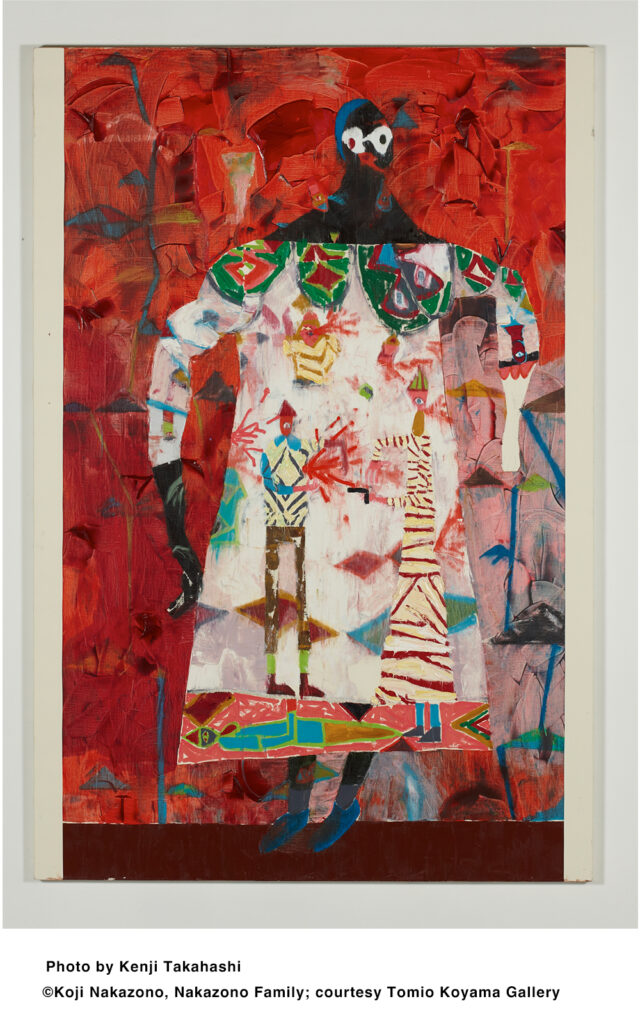
Koji Nakazono, Untitled, 2012, collection of Satoshi Shiraki and Michiyo Kamata
Nakazono’s passion since elementary school had been basketball, but he suddenly quit playing to attend preparatory art school and enrolled directly in the oil painting department at the Tokyo University of the Arts. His work for the graduation exhibition was purchased by Tomio Koyama, who then organized a solo show in his Tomio Koyama Gallery. Nakazono himself left home after graduation and set up a studio in Kitamatsudo (Chiba), then Omiya (Saitama), and finally Takamatsu (Kagawa, in the island of Shikoku), where he died. Each exhibition during this time won him ever greater critical acclaim.
Life as a painter, however, was not all smooth sailing. Nakazono struggled emotionally and at times felt depressed. He walked in the woods at night and sneaked into abandoned buildings and idled the time away until dawn. He craved a sense of fulfillment—this promising artist who met an untimely demise. Just as he lived by his own standards, he also worked by his own standards. Nakazono let very few people watch him at work. Nevertheless, some say they know that he used his elbows, fingers, towels, and various other “paintbrushes” to faithfully express his breath and desire. Nakazono’s work is at once elaborate and impromptu, and more often than not, it’s described in bodily terms. He himself has said in an interview that it’s important for him to produce work in bulk. That just shows the prolific artist must have been brimming with breath, desire, and physicality.
Then, what drove him to paint? One hazy answer to that question lies in the title of the exhibition on now at the Marugame Genichiro Inokuma Museum of Contemporary Art, in the city of Marugame, close to Takamatsu, where Nakazono spent his last years. The show presents some 220 works under the title Soulmate. Nakazono may have seemed confident about painting, but he was constantly searching for someone who understood his deep inner feelings. It was as if his creative process took him deep underwater, and he needed someone to recognize that he was down there.

Koji Nakazono, Untitled, 2015, collection of Museum of Contemporary Art Tokyo
Koji Nakazono: Soulmate is divided into several themes. A wall named “Countless Sceneries,” for instance, displays small-sized improvised works, focusing on the breadth of variation. “People” presents countless faces, some with only eyes or mouths like game characters, and others that blur the line between human and ghost.
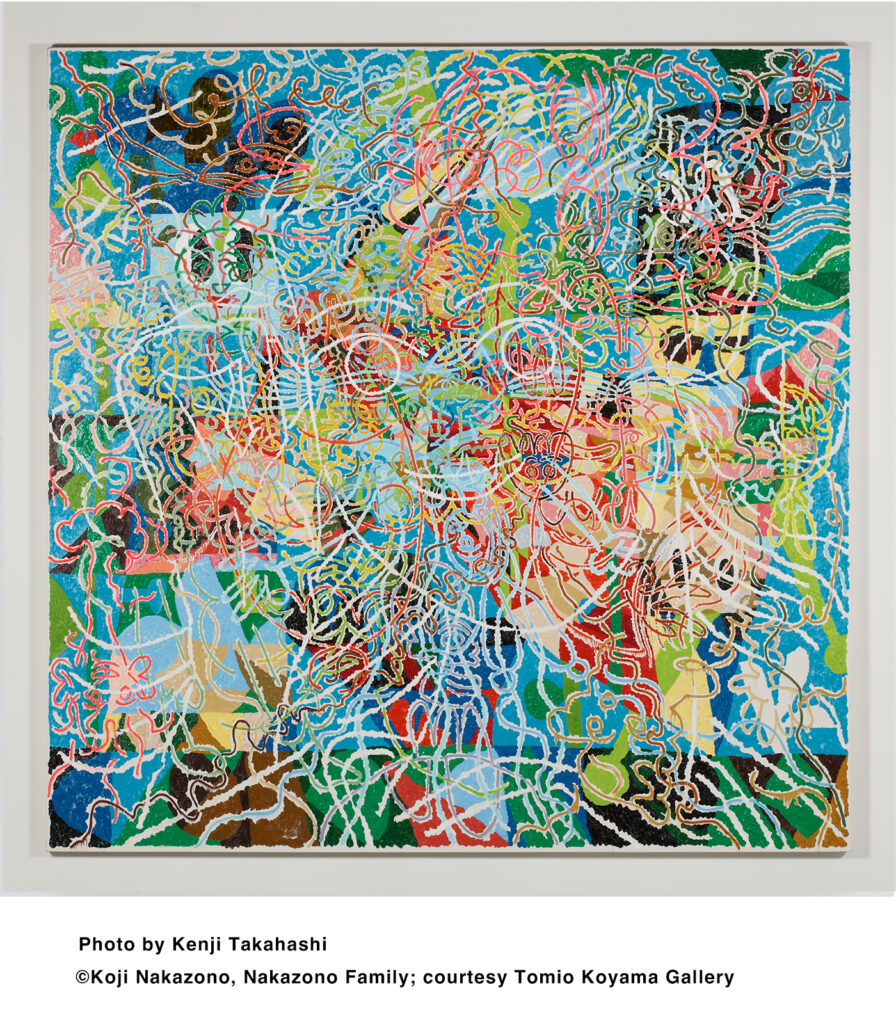
Koji Nakazono, Untitled, 2013, collection of sasanao
My favorite piece of all is one with distinct complex layers, from the series featured on the cover of Nakazono’s book of paintings. This large work perfectly showcases Nakazono’s signature nested structure, and the section itself, themed “Multilayered Scenery,” is also laid out in a nested structure, with new spaces created within the space to offer the experience of the multiple layers.
In the work, these layers are intricately piled and arranged on top of one another to bursting point. Up close, the viewer can make out small faces playfully scattered across the canvas. And when the viewer steps back and zooms out, a large face appears. Hearing that Nakazono outlined this large face first, I let out a sigh of admiration—how bold! At the same time, I studied the meticulously stacked layers of color and thought I glimpsed his finer side. This work encapsulates the conflicting characters dwelling within Nakazono, doesn’t it? It embraces his breath and desire, doesn’t it? The moment I realized this, I was moved to tears. I had started out interviewing Nakazono’s friends and acquaintances so that I can better understand the late artist. That process brought me closer to Nakazono, and finally, I met him face-to-face in his art.
Each painting on display is an embodiment of the artist. He is in there. Nakazono is present.
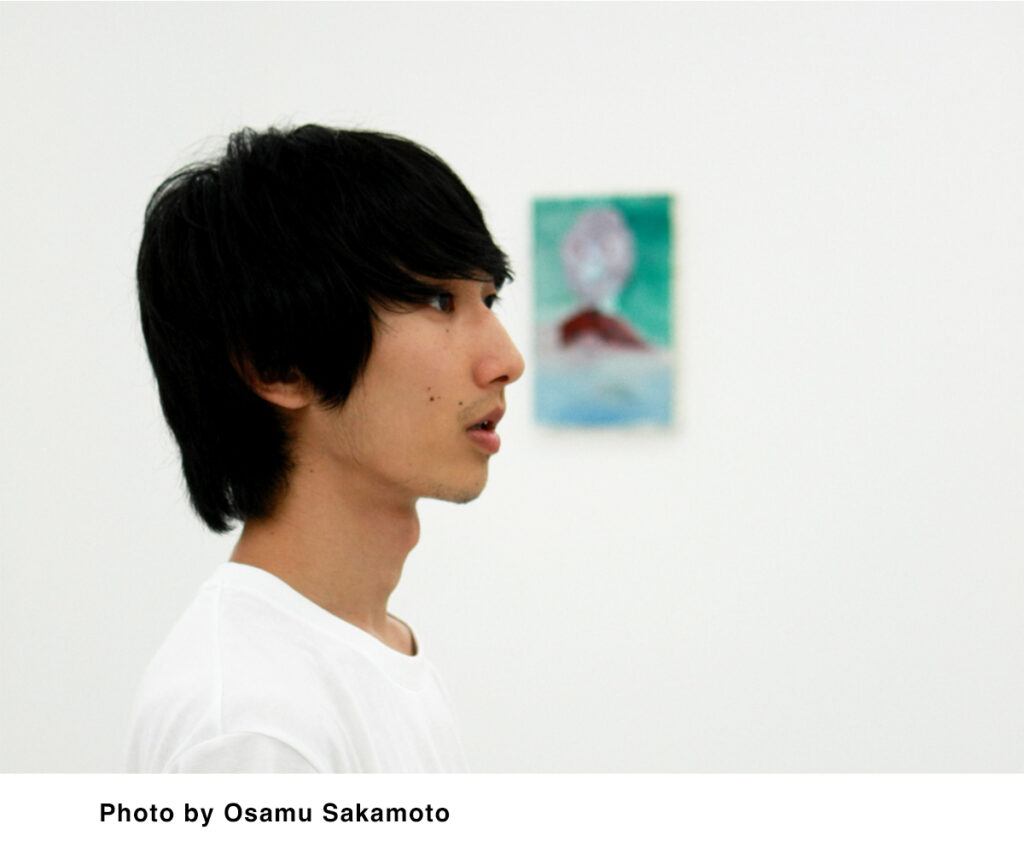
Koji Nakazono
Koji Nakazono was born in 1989 in Yokohama City, Kanagawa Prefecture. In 2012, he completed the Oil Painting Course and graduated from the Department of Painting, Faculty of Fine Arts, Tokyo University of the Arts. He died in the Seto Inland Sea in 2015. Major solo exhibitions include Koji Nakazono (Tomio Koyama Gallery, Tokyo, 2013) and Koji Nakazono: On the Edge—Places I Wanted to See (Yokosuka Museum of Art, Kanagawa, 2018); group exhibitions include The Way of Painting (Tokyo Opera City Art Gallery, Tokyo, 2014), New Vision Saitama 5: The Emerging Body (Museum of Modern Art, Saitama, Saitama, 2016), and Japanorama: A New Vision on Art Since 1970 (Centre Pompidou-Metz, France, 2017).
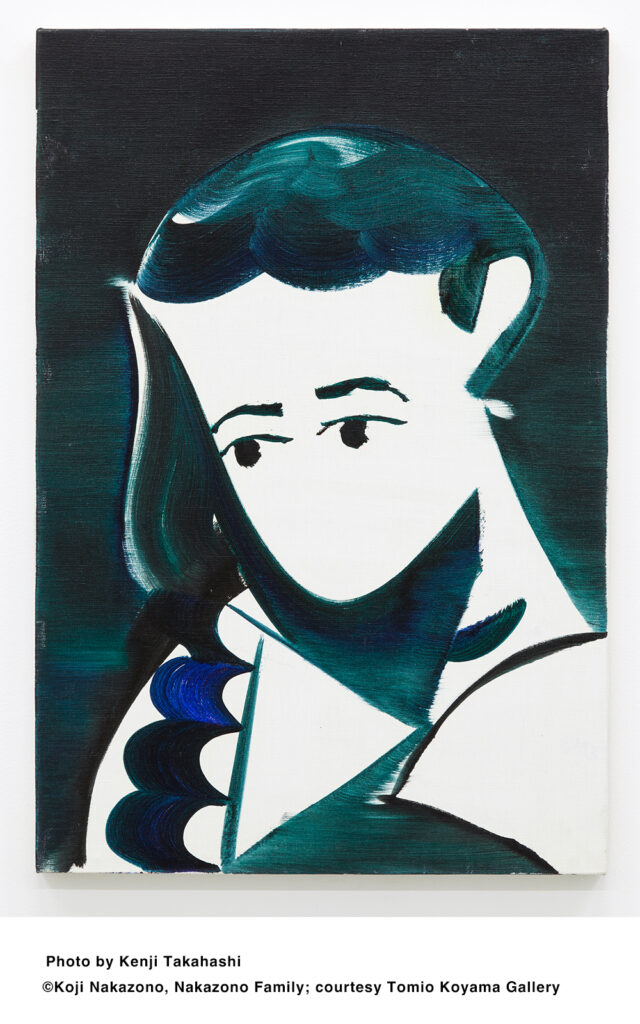
Koji Nakazono, Untitled, ca. 2013 or 2014
Koji Nakazono: Soulmate
Dates: Sat., June 17–Mon. (holiday), September 18, 2023
Venue: Marugame Genichiro Inokuma Museum of Contemporary Art
Closed: Mondays (except July 17 and September 18) and Tue., July 18
Hours: 10:00–18:00 (doors close at 17:30)
Odayaka na ghost: Gaka Nakazono Koji wo otte
(The Gentle Ghost: Homage to Painter Koji Nakazono)
Toshiya Muraoka
Painter Koji Nakazono was a promising artist who died suddenly in 2015, at the age of 25. This critical biography is based on painstaking interviews with his parents, friends, and girlfriends as well as the artist’s 150 sketchbooks. Illustrated in color. Available for 3,630 yen (including tax) from Shinchosha Publishing.
